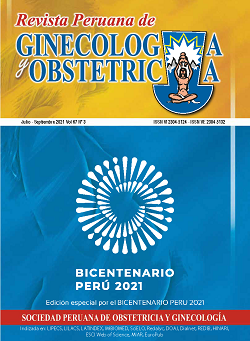Teaching in gynecology and obstetrics in Peru
DOI:
https://doi.org/10.31403/rpgo.v67i2340Keywords:
Education, medical, undergraduate, postgraduate, Obstetrics and Gynecology, Coronavirus infectionsAbstract
The teaching of obstetrics and surgery in Peru began at the beginning of the 19th century, at the initiative of Hipólito Unanue. Cayetano Heredia and others structured it academically when the Faculty of Medicine of the Universidad Nacional Mayor de San Marcos was created in 1856. The chair of clinical gynecology was created at the end of the 19th century, appointing Constantino T. Carvallo as professor. In 1947, the Peruvian Society of Obstetrics and Gynecology (SPOG) was founded with the purpose of developing the science and continuous training of specialists in gynecology and obstetrics. Since 1955, The Peruvian Journal of Gynecology and Obstetrics is the scientific communication media of the SPOG, which publishes experiences and research in the specialty. The residency in Obstetrics dates back to 1958 at the Maternity Hospital of Lima and, between 1961 and 1962, Abraham Ludmir began the schooled residency in obstetrics and gynecology at the Hospital Materno Infantil San Bartolomé. The continuous and rapid progress given by scientific research, information and modernization of technology in the specialty has caused the emergence of several branches related to the pathology of women and perinates, integrated in medical institutions that advance at different speed and importance. The current SARS-CoV-2 coronavirus pandemic has highlighted the problems in national health care, resulting in hospital congestion, insufficient equipment, drugs and human resources, unfavorable indicators of surveillance, infections and deaths, which will require a change in health management. Teaching in medicine was also affected, with the conversion from classroom to virtual education, prohibition of on-site care for students and senior teachers, who will be returning to the hospitals. Medical education, scientific and technological advances and the vision of a rapidly changing world must give rise to new curricular pla students and residents in the specialty, for appropriate health care.
Downloads
Downloads
Published
How to Cite
Issue
Section
License
Copyright (c) 2021 Manuel Antonio Ciudad-Reynaud, José Pacheco-Romero

This work is licensed under a Creative Commons Attribution 4.0 International License.
Esta revista provee acceso libre inmediato a su contenido bajo el principio de que hacer disponible gratuitamente la investigación al publico, lo cual fomenta un mayor intercambio de conocimiento global.















